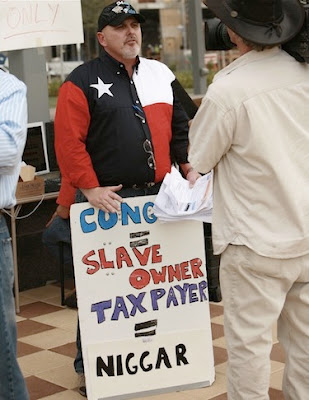Have you read it, yet? Good. Now, let's go on.
 Wise makes some interesting observations about the "Tea Party Movement" and the nature of race in the United States, particularly the phenomenon of white privilege in the way we perceive "threats" to our security. He leads me to wonder how our society become so,.. well... stupid that we can look at a bunch of lunatics carrying guns to town hall meetings and hold them up as examples of patriotism and support forthe second amendment? Have we become so accustomed to far-right-wing radio and television that we can't see spitting on legislators and hurling racial epithets at them as anything more than a legitimate use of the first amendment? Are we really so delusional as to believe that these extremists who carry posters of political rivals in the crosshairs of a rifle scope only mean it metaphorically?
Wise makes some interesting observations about the "Tea Party Movement" and the nature of race in the United States, particularly the phenomenon of white privilege in the way we perceive "threats" to our security. He leads me to wonder how our society become so,.. well... stupid that we can look at a bunch of lunatics carrying guns to town hall meetings and hold them up as examples of patriotism and support forthe second amendment? Have we become so accustomed to far-right-wing radio and television that we can't see spitting on legislators and hurling racial epithets at them as anything more than a legitimate use of the first amendment? Are we really so delusional as to believe that these extremists who carry posters of political rivals in the crosshairs of a rifle scope only mean it metaphorically?That racism figures into all of this should be readily apparent, but Wise spells it out with such clarity that only those who have a vested interest in not understanding could fail to understand. Despite the fact that the President is black -- or, most likely, BECAUSE the President is black -- the radical right has become even more radicalized. We see this not only in the way that the far-right has branded Obama as a "socialist" but also in the way that xenophobia has resurfaced as a key plank in right-wing politics. One major case in point being the legislation that Arizona Gov. Janice Brewer signed into law yesterday, which subjects Hispanics to random stops by law enforcement officals and essentially makes it a crime for Hispanics in her state to fail to carry identification at all times.
It is time for us to say "Enough!" It is time for liberals and moderates and sane conservatives to stand together and call a spade a spade, to say plainly that the "Tea Party" has more in common with Germany's brown-shirts than it does with the Boston Tea Party, to denounce racial profiling and the creation of a police-state in Arizona, and to realize that White America's accusation that people of color are "playing the race card" is, itself, a form of racializing problems that we should all be working on, together.


